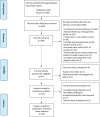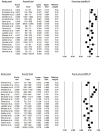COVID-19 vaccine hesitancy among healthcare workers in Arab Countries: A systematic review and meta-analysis
- PMID: 38166119
- PMCID: PMC10760888
- DOI: 10.1371/journal.pone.0296432
COVID-19 vaccine hesitancy among healthcare workers in Arab Countries: A systematic review and meta-analysis
Abstract
Background: Vaccine hesitancy is a major obstacle to the large efforts made by governments and health organizations toward achieving successful COVID-19 vaccination programs. Healthcare worker's (HCWs) acceptance or refusal of the vaccine is an influencing factor to the attitudes of their patients and general population. This study aimed to report the acceptance rates for COVID-19 vaccines among HCWs in Arab countries and identify key factors driving the attitudes of HCWs in the Arab world toward vaccines.
Methods: This systematic review and meta-analysis followed the PRISMA guidelines. PubMed and Scopus databases were searched using pre-specified keywords. All cross-sectional studies that assessed COVID-19 vaccine hesitancy and/or acceptance among HCWs in Arab countries until July 2022, were included. The quality of the included studies and the risk of bias was assessed using the JBI critical appraisal tool. The pooled acceptance rate of the COVID-19 vaccine was assessed using a random-effects model with a 95% confidence interval.
Results: A total of 861 articles were identified, of which, 43 were included in the study. All the studies were cross-sectional and survey-based. The total sample size was 57,250 HCWs and the acceptance rate of the COVID-19 vaccine was 60.4% (95% CI, 53.8% to 66.6%; I2, 41.9%). In addition, the COVID-19 vaccine acceptance rate among males was 65.4% (95% CI, 55.9% to 73.9%; I2, 0%) while among females was 48.2% (95% CI, 37.8% to 58.6%; I2, 0%). The most frequently reported factors associated with COVID-19 vaccine acceptance were being male, higher risk perception of contracting COVID-19, positive attitude toward the influenza vaccine, and higher educational level. Predictors of vaccine hesitancy most frequently included concerns about COVID-19 vaccine safety, living in rural areas, low monthly income, and fewer years of practice experience.
Conclusion: A moderate acceptance rate of COVID-19 vaccines was reported among HCWs in the Arab World. Considering potential future pandemics, regulatory bodies should raise awareness regarding vaccine safety and efficacy and tailor their efforts to target HCWs who would consequently influence the public with their attitude towards vaccines.
Copyright: © 2024 Alalawi et al. This is an open access article distributed under the terms of the Creative Commons Attribution License, which permits unrestricted use, distribution, and reproduction in any medium, provided the original author and source are credited.
Conflict of interest statement
The authors have declared that no competing interests exist.
Figures
References
-
- Lynch HJ, Marcuse EK. Vaccines and immunization. In: The Social Ecology of Infectious Diseases. 2007. pp. 275–299. doi: 10.1016/B978-012370466-5.50015-7 - DOI
Publication types
MeSH terms
Substances
LinkOut - more resources
Full Text Sources
Medical





